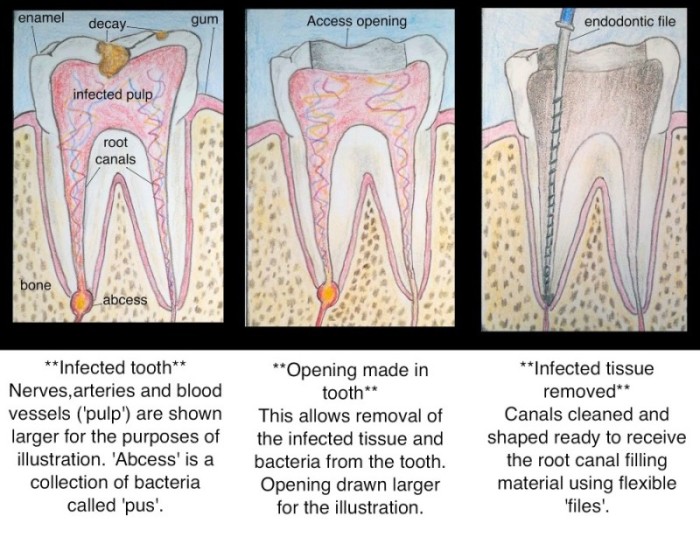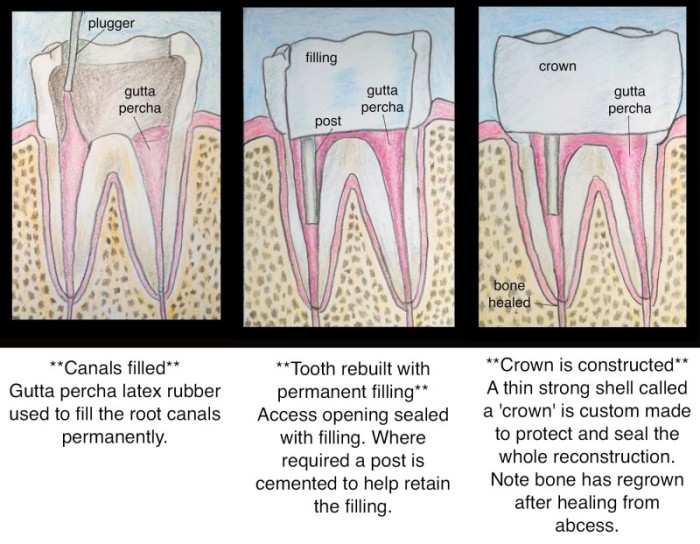root canal treatment
WHAT IS ROOT CANAL TREATMENT?
Root canal treatment (RCT) is also known as endodontics or ‘root canal therapy’. It involves removing infected or damaged tissue (‘pulp’ see below) from inside the root canals of a tooth. An infected and untreated root canal allows bacteria to collect forming an abscess which destroys the bone beneath the tooth. From there infection enters the bloodstream and travels to other parts of the body. Root canal treatment allows the tooth to be saved and prevents the spread of infection through the body. It significantly restores damaged teeth and is a superior alternative to tooth extraction if the tooth is savable.


WHY RCT?
A tooth is made up of the following layers:
Enamel: The hard outer layer of the tooth.
Dentine: This forms the core structure of the tooth, giving it its basic shape and supporting the enamel from underneath. It is softer than enamel but harder than bone.
Pulp: This is the central part of the tooth which contains the nerves, arteries and blood vessels. It lies within the root canal(s). Root canals are very small, thin passageways that branch off from the top pulp chamber through the root tip, communicating with the bloodstream. A tooth can have up to four or even five root canals.
Here are three very common causes of damage to the pulp, often resulting in the pulp dying:
Caries: Bacterial infection of the tooth and the most common cause of pulp death. If caries (‘decay’) is left untreated it will travel through the enamel and dentine down into the pulp chamber causing inflammation and eventual death with spread of infection beyond the tooth.
Trauma: A severe knock that damages the pulp and or fractures/cracks that directly exposes the pulp to bacteria from the mouth.
Severe Gum Disease (periodontitis): The attachment of the tooth to the bone is destroyed by plaque bacteria, creating a gap between the tooth and the gum. Bacteria travel deep under the gum and through the side of the tooth causing infection of the pulp.
Signs and symptoms of pulp inflammation or death:
Pain: This can be anything from a constant background dull ache to very severe sharp pain, pain only when biting or a vague discomfort.
Draining sinus: A spot resembling a pimple appears on the gum in the area of the infected tooth. This is where the collection of pus from the root tip is draining which often leaves a bad taste in your mouth.
Swelling: This usually occurs in the gum area surrounding your tooth either on the inside or cheek side.
THE PROCEDURE:
-Access is gained into the tooth, firstly removing all decay/leaking fillings and allowing for root canal treatment to be commenced.
-The infected or damaged pulp is removed from the inside the root canal(s) of the tooth via the small access hole.
-The root canals are then cleaned, disinfected and shaped to a form that can be completely sealed.
-The final stage is to seal (fill) the root canals with a filling material to prevent re-infection.
This process can take one or several appointments, depending on how complex your tooth is. Teeth vary in shape depending on the number, length and curvature of the root canals. If a tooth is particularly complex and beyond the scope of general dentistry it is best for a RCT specialist called an endodontist to handle the job. I work with excellent endodontists who are all located in the CBD of Melbourne.
A sheet of rubber (“rubber dam”) is used to isolate and protect the tooth during each visit. This prevents debris from within the tooth entering the mouth, and saliva and bacteria from the mouth entering the tooth during the root canal treatment process. A metal band may also be placed around your tooth, to protect the tooth and help retain the temporary filling. This band remains in place until the crown of the tooth is restored.
Sedative dressings are usually placed inside your tooth between each visit to help settle the surrounding tissues and destroy remaining bacteria. Temporary fillings are used to seal the access hole during the process. In between visits you can use your tooth for chewing, but you must be careful to avoid very hard or sticky foods.
